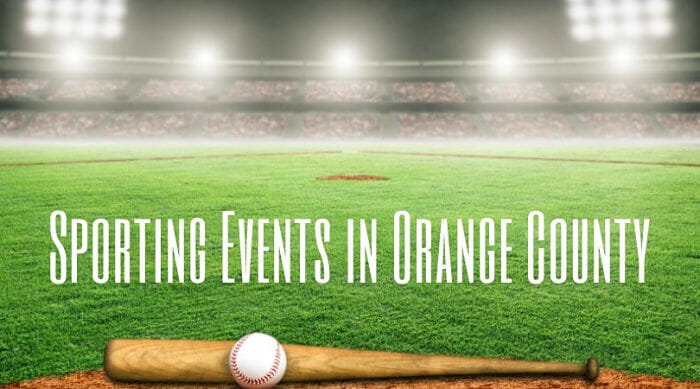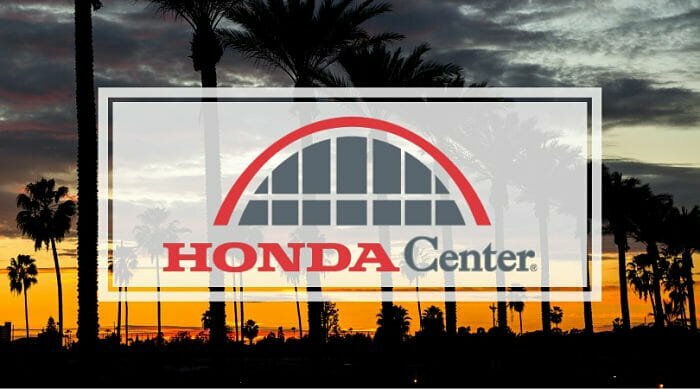Angel Stadium of Anaheim.
Anaheim Stadium.
Edison International Field.
The Big A.
The Big Ed.
Call it what you will… pretty much everyone in Orange County knows exactly what sports facility you’re talking about.
But it’s only the die-hard fans that know the whole story of Angel Stadium.

Angel Stadium is the fourth oldest active Major League Baseball stadium in the country. It’s seen a lot of history… it’s the current home for the Los Angeles Angels. It’s hosted the Major League Baseball All-Star games in 1967, 1989, and 2010. It’s even done a fourteen-year stint as the home for the Los Angeles Rams.
While Anaheim Stadium’s football days are long gone, the sports complex still literally lights up the night in downtown Anaheim, offering great games and great experiences for fans.
Keep reading to learn about the history of this great Orange County baseball stadium.
Angel Stadium
Address: 2000 E Gene Autry Way, Anaheim, CA 92806
Parking Entrances
- State College Parking Entrance
- Katella Avenue Parking Entrance
- Orangewood Parking Entrance
The Orangewood parking entrance is for general and premier parking.
Rideshare
Rideshare is located near Angel Stadium Lot 1B between State College and the third base (West side) of the stadium.
Rideshare (Uber, Lyft, etc.) drop-offs can enter through the Orangewood entrance and use the Orangewood Bus & VIP Entrance when entering the lot. The State College entrance can also be used and is actually closer to the Rideshare dropoff/pickup location.
There are also the ARTIC METROLINK Station located right next to the stadium.
Angel Stadium Events
Baseball Season
Angels Baseball Season runs from March through September. During regular season, the Angels host several events after the game including Family Sunday/Kids Run the Bases, Post-game fireworks on weekends, and movie nights. Availability and details of these events can be found on the team ticket schedule. See the Angel’s website for detailed information about schedules, tickets, and more.
Ballpark Tours
Public tours are available during regular season from March through September. Private Tours are available all year and must be scheduled two weeks in advance. Each 75-minute tour includes visits to the field, the dugout, the visitors clubhouse, access to the Clubhouse Press Conference Room, and exclusive views of the Broadcast Booth, Dugout Suite, and the Gene Autry Suite.
5Ks and Fun Runs
Angels Stadium is a popular event venue for 5Ks, fun runs, and walks throughout the year. Some events include the Down Syndrome Association of Orange County’s Buddy Walk, Walk4ALZ, Anaheim Turkey Trot, Hike The Halo, JDRF One Walk, and more.
AMA Supercross
On select dates in January, Angel Stadium is overrun by motorcycle mayhem. Fierce competitors battle it out on obstacle courses and race to the finish. AMA Supercross is a popular annual event here that also includes VIP experiences, meet and greets, and more.
Monster Jam
It’s loud. It’s crazy. It’s exhilarating. Every year, notorious monster trucks like Monster Mutt, Stone Crusher, and Grave Digger roar into Angel Stadium to kick up the dust and crush their competitors. Monster Jam events typically take place on select dates in January and February.
Angel Stadium History
There probably wouldn’t be an Anaheim Stadium without Disneyland.
It sounds crazy, but it’s true. One of the reasons Anaheim was chosen to hold the home of the Los Angeles Angels was the proposed site’s proximity to Disneyland and the major freeways, making Anaheim just that much more of an Orange County entertainment destination.
Fun fact: That’s not where Disney’s involvement in Anaheim Stadium ends… Keep reading.
The $24 million dollar, 43,204 seat stadium wasn’t the only thing in Anaheim that was new… the Los Angeles Angels changed their name to match their new home. The California Angels took to the field to battle the Chicago White Sox on April 19, 1966 (sadly, the Sox won 3-1, despite a valiant effort by the Angels).
From its inception, Anaheim Stadium had been intended as a three-sided baseball arena… but it didn’t stay that way for long. If the 1960s were the beginning of Anaheim Stadium’s sports career, within a decade, it was expanding in a very different direction. The NFL’s Los Angeles Rams came to town and liked what Anaheim Stadium had to offer: a smaller, cozier home stadium than the massive 100,000 seat Los Angeles Coliseum they were currently based out of.
The Angels didn’t mind roommates, so in the 1970s, the Los Angeles Rams traded their home in the Los Angeles Coliseum for the rights to share Anaheim Stadium with their baseball brethren. By 1980, Anaheim Stadium had grown, closing off its open third side and adding about 23,000 seats to grow itself into a true multi-sport stadium. The change didn’t exactly please a lot of Angels fans… the original layout of Anaheim Stadium put every seat no more than 109 feet from the field, allowing a great view of the action on the baseball diamond. The new changes, however, put most of the new center field seats too far from the field to truly see the details of the game.
Anaheim Stadium’s history seems to work in 10-year waves. If the 1960s were about baseball, and the 1970s were about football and baseball, the 1990s were about the Angels getting a little tired of sharing their room with another team and working in what was essentially an entertainment venue. Plans for reconfiguration or renovation – or outright moving the Angels out of Anaheim altogether – got a drastic boot when the facility was damaged to the tune of $4 million dollars during the 1994 Northridge earthquake.
1994 also marked the turning point when Anaheim Stadium went back to having only one tenant… the Los Angeles Rams really did pick up stakes and move all the way to Saint Louis, which gave controlling interest back over to the Angels again.
While Anaheim Stadium went back to being a shrine to America’s greatest game, the facility wasn’t done with change. The stadium was aging, and it needed renovations to stay both safe and relevant.
That was when the Mouse down the road came to the rescue of its neighbor. The Walt Disney company, a minority owner of the team, gained enough support on the governing board to take control.
Guess what happened next?
The Disney Era
Disney bought the Angels in 1996. Part of the deal was that Disney would cover 70% of the $100 million dollars needed for Anaheim Stadium’s most recent renovation.
If you ever wondered why Anaheim Stadium has a front façade whose support beams look like over-sized baseballs… or why the shade structures in the front of the stadium are perfect, massive replicas of Angels baseball hats… or why there’s a magnificent display feature of artificial rock with cascading streams and erupting geysers behind the left-center field fence… well, it’s Disney. Pride Rock isn’t just a spectacular display of Imagineering, though. It’s a functional part of Angels games: the display fires fireworks at the start of games, and after every home run and victory the Angels manage.
Fun fact: Prior to the installation of the California Spectacular geyser and mountainside, Angels games fireworks were fired from a nearby parking garage.
The renovated stadium opened with a game between the Angels and the New York Yankees on April 1, 1998. This rededication game went better than the Angels’ original 1966 game against the Chicago White Sox. The Angels slammed their way to a 4-1 victory over their East Coast rivals and properly christened the new stadium with its 78 luxury suites and about 5,000 club seats.
Nothing stays static at Anaheim Stadium, especially the name. In 1998, it got a new rename due to a sponsorship deal between Edison International and the Angels. Anaheim Stadium became known as Edison International Field, and the Los Angeles Angels became the Anaheim Angels.
Remember what we said about Anaheim Stadium having 10 year patterns? This isn’t one of them. The naming agreement with Edison International ended after only five years, and the stadium took its current name, Angel Stadium of Anaheim. In 2005, the Angels also reclaimed their original name and now go by the Los Angeles Angels once again.
History really does repeat itself, doesn’t it?
Fun fact: The massive hats outside the stadium were initially blue and had Disney’s winged 1997 Angels logo on them. They were repainted Angels red and got a logo update in time for the 2002 season.
Anaheim Stadium Today
Despite being over fifty years old at this point, Anaheim Stadium has been renovated enough that it looks a great deal like other retro-style stadiums half its age. It’s currently an entertainment mecca that boasts MLB shops, the Angels Organization’s business offices, and the Angels’ official radio station. It’s hosted football games, the 2002 World Series, three All Star Games, Reggie Jackson’s 500th homerun, Albert Pujols’ 600th homerun, Harvest Crusades, and Monster Truck rallies.
Anaheim Stadium is the lodestone in downtown Anaheim, presiding over a growing, vibrant downtown community. The Big A may be old, but she’s got a lot of life, and a lot of baseball, left in her.
Movies Filmed at Angel Stadium
- Air Bud: Seventh Inning Fetch (2002)
- Angels In The Outfield (1994)
- Deuce Bigalow: Male Gigalo (1999)
- My Stepmother Is An Alien (1988)
- Taking Care of Business (1990)
- The Fan (1996)
- The Naked Gun: From the Files of Police Squad! (1988)
- Waking up in Reno (2002)
Angel Stadium of Anaheim is located at 2000 Gene Autry Way, Anaheim, CA 92806.
Related Articles
| Honda Center | Orange County Fair & Event Center |
| Orange County Golf Courses | Orange County 5Ks and Fun Runs |
| Fishing In Orange County | Sporting Events In Orange County |




